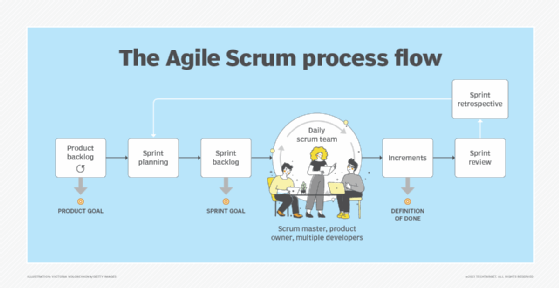
pathdoc - stock.adobe.com
How to write a sprint goal in Scrum
The product of every sprint planning session is a sprint goal. Here, we look at its purpose along with how to write a sprint goal properly.
Scrum doesn't have many hard and fast rules, but it does have one requirement for Scrum teams: Before the sprint planning event ends, they must articulate a well-thought-out sprint goal.
A good sprint goal is the springboard to an effective sprint. Unfortunately, very few Scrum teams know how to properly write one. Let's take a closer look at what goes into an effective sprint goal.
The purpose of a sprint goal
A well-written sprint goal should accomplish the following:
- Promote creativity.
- Enhance focus.
- Provide opportunities for agility.
- Encourage teams to adapt.
It's always a challenge for new Scrum teams to get the sprint goal right. It isn't always clear for those who are inexperienced with Scrum to understand the benefits of the sprint goal, and the way it can motivate and drive the team.
However, with a little guidance and coaching, teams quickly learn how to write a sprint goal that checks all the right boxes and helps the team create high-quality increments each iteration.
How to write a sprint goal
The most effective approach for a sprint goal incorporates three aspects:
- Opportunity discovery.
- Identify risky assumptions.
- Formulate and test hypotheses.
This approach empowers teams to be customer-centric, adaptive and innovative.
Opportunity discovery
Opportunity discovery is the foundation where a Scrum team sets meaningful sprint goals.
In this step, teams proactively seek out the next right thing to build. They evaluate and validate opportunities, and co-create the product with the product owner, UX designers and engineers along with other key players to drive value. The key is to understand what the customer needs and wants, not just what's in the product backlog.
Imagine that a team develops a fitness app. Through the discovery phase, they find a growing interest in mindfulness and mental wellness among their target users. Determining that consumers increasingly seek an app to address both explicit and hidden needs of mental health is a critical discovery.
Identify risky assumptions
Risky assumptions are unknowns that, if proven false, could derail a project or render it ineffective. Identifying such assumptions before they cause trouble is the best way to de-risk the product.
In the example above, the risky assumptions are that users will engage with mindfulness features within the app, and that this feature will positively impact user retention.
Form and test a hypothesis
A hypothesis is a testable statement that serves as the foundation for the team's sprint goal. It should address the riskiest assumptions and articulate what the team believes will happen if certain conditions are met.
Here is such a hypothesis for the above example: "If we integrate mindfulness features into our fitness app and 30% of users engage with them regularly, user retention will increase by 15%."
After formulation of the hypothesis comes the crux of setting a sprint goal: Create specific objectives that test the hypothesis.
Teams should design these goals to gather data and insights to validate assumptions. The team's sprint goal for the above example could be: "Develop and launch mindfulness features within the app and measure user engagement and retention over the next two weeks."
Throughout the sprint, the Scrum team should actively collect feedback from users, stakeholders and team members. This feedback loop is essential to monitor progress and adjust as needed. It ensures that the sprint goal remains aligned with the overarching hypothesis and market realities.

A proper sprint goal focuses on customers
The three-pronged approach to help teams write a sprint goal is rooted in enabling them to discover opportunities based on real customer needs, and pivot and respond to changing market conditions and user preferences. Hypothesis testing and feedback collection provide valuable insights for future iterations.
In Agile software development, setting a sprint goal is more than just assigning tasks; it's an opportunity to create value and innovate. Other ways to set sprint goals have merits, but they fall short because they do not provide a holistic, adaptable approach.
In a dynamic business environment, the sprint goal method described above empowers teams to innovate and deliver value that aligns with both customer needs and strategic objectives. Teams that continually test assumptions and gather feedback can fine-tune their sprint goals and stay ahead in a competitive landscape. Ultimately, this ensures that each sprint is a step forward in achieving long-term success.
Ashok P. Singh is a product coach and author who helps companies deliver high-quality products end to end by simplifying agile software/product development.








